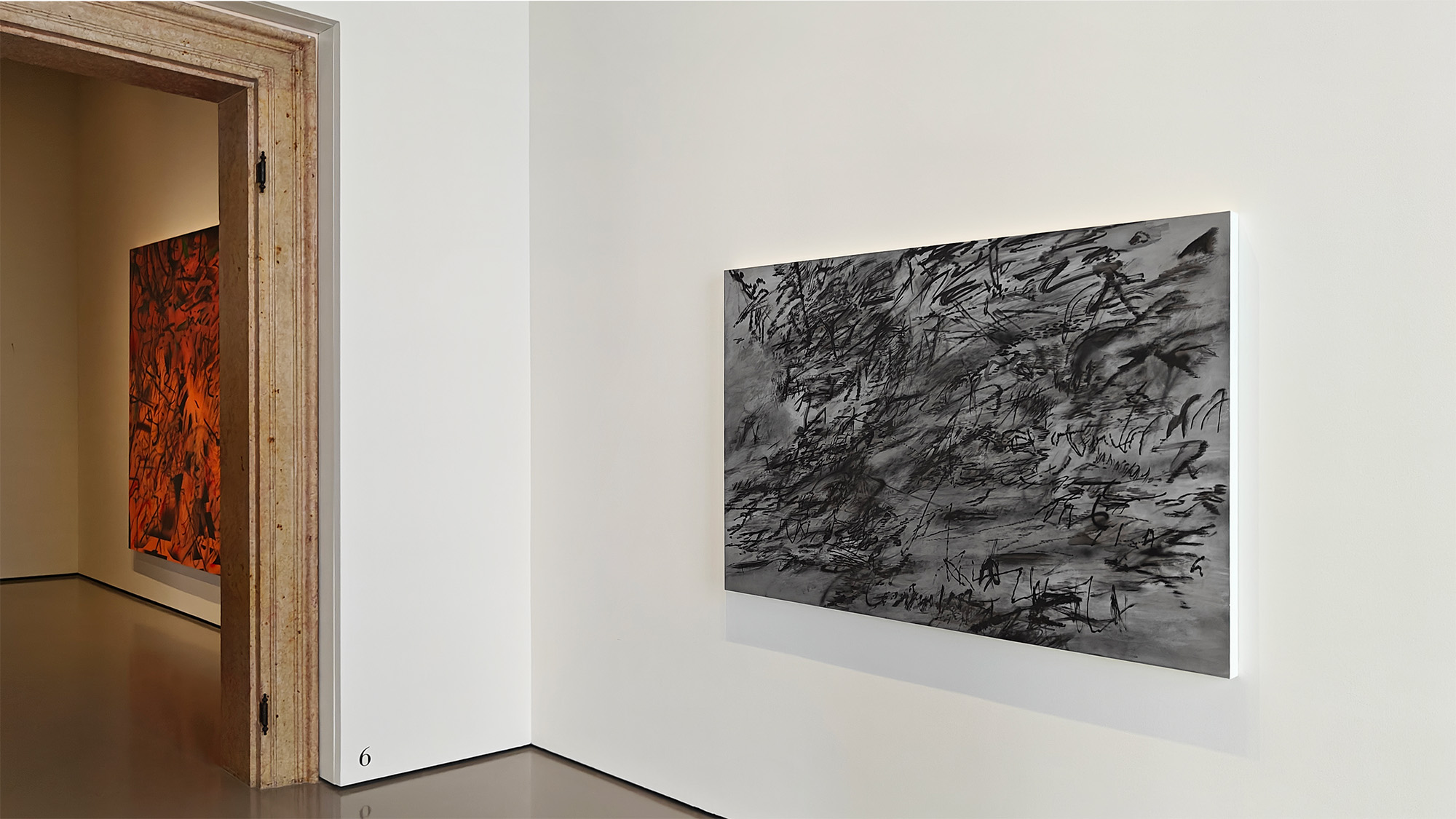Venice 2024: the best of the rest
With only a few days left of this year’s edition of the Venice Biennale of Art, we round up some of the best projects from across the Island not yet covered in recessed.space. As well as Czech, Romanian, Finnish, Croatian & Canadian national pavilions, we have projects from global artists with an architectural twist.
At recessed.space we are already planning accommodation and
logistics for next year’s Venice Biennale of Architecture, but the energy of
ideas and installations from this year’s Art edition are still strong in the
memory. It is always the case that each edition contains far too much to
properly cover in a single publication.
Despite having already brought you a lot (an interview with Golden Lion-winning Archie Moore (00194), Pierre Huyghe’s animalistic darkness (00207), the Korean landscapes of Yoo Youngkuk (00205), Osman Yousefzada’s study of immigration (00202), Hildigunnur Birgisdóttir’s capitalism (00196), Robert Zhao Renhui’s edgeland (00191), Anna Jermolaewa’s refugee architectures (00187), immersive worlds from Switzerland and LAS (00231), spatial memories of Bulgaria and Serbia (00223), and a unique photographic essay by photographer Carlo Zambon (00217) – there is still more.
So, here is a quickfire roundup of the best of the rest. With the Biennale ending in only a week’s time you may not have time to get to the lagoon to check it out for yourself, but we hope that it might introduce you to a range of ways arts and architectures overlap at the oldest Biennial.
Despite having already brought you a lot (an interview with Golden Lion-winning Archie Moore (00194), Pierre Huyghe’s animalistic darkness (00207), the Korean landscapes of Yoo Youngkuk (00205), Osman Yousefzada’s study of immigration (00202), Hildigunnur Birgisdóttir’s capitalism (00196), Robert Zhao Renhui’s edgeland (00191), Anna Jermolaewa’s refugee architectures (00187), immersive worlds from Switzerland and LAS (00231), spatial memories of Bulgaria and Serbia (00223), and a unique photographic essay by photographer Carlo Zambon (00217) – there is still more.
So, here is a quickfire roundup of the best of the rest. With the Biennale ending in only a week’s time you may not have time to get to the lagoon to check it out for yourself, but we hope that it might introduce you to a range of ways arts and architectures overlap at the oldest Biennial.
Pia
Lindman, Vidha Saumya & Jenni-Juulia Wallinheimo-Heimonen
The pleasures we choose
Finnish pavilion
Though one of the smallest of the national pavilion buildings, Finland’s Alvar Aalto-designed space sits central in the Giardini, artists Pia Lindman, Vidha Saumya, and Jenni-Juulia Wallinheimo-Heimonen manage to fit a lot in to their exploration of into their exploration of imagining and inhabiting a more plural world. The tight space becomes an entanglement of different ways of experiencing, using architecture as an empathetic frame to think about others use of space and time. It’s all pulled together by architectural designer Kaisa Sööt with an “access architecture” which considers access and bodily needs with sensorial experiences.
more info: www.frame-finland.fi/en/the-pleasures-we-choose-pavilion-of-finland-at-the-60th-la-biennale-di-venezia
The pleasures we choose
Finnish pavilion
Though one of the smallest of the national pavilion buildings, Finland’s Alvar Aalto-designed space sits central in the Giardini, artists Pia Lindman, Vidha Saumya, and Jenni-Juulia Wallinheimo-Heimonen manage to fit a lot in to their exploration of into their exploration of imagining and inhabiting a more plural world. The tight space becomes an entanglement of different ways of experiencing, using architecture as an empathetic frame to think about others use of space and time. It’s all pulled together by architectural designer Kaisa Sööt with an “access architecture” which considers access and bodily needs with sensorial experiences.
more info: www.frame-finland.fi/en/the-pleasures-we-choose-pavilion-of-finland-at-the-60th-la-biennale-di-venezia

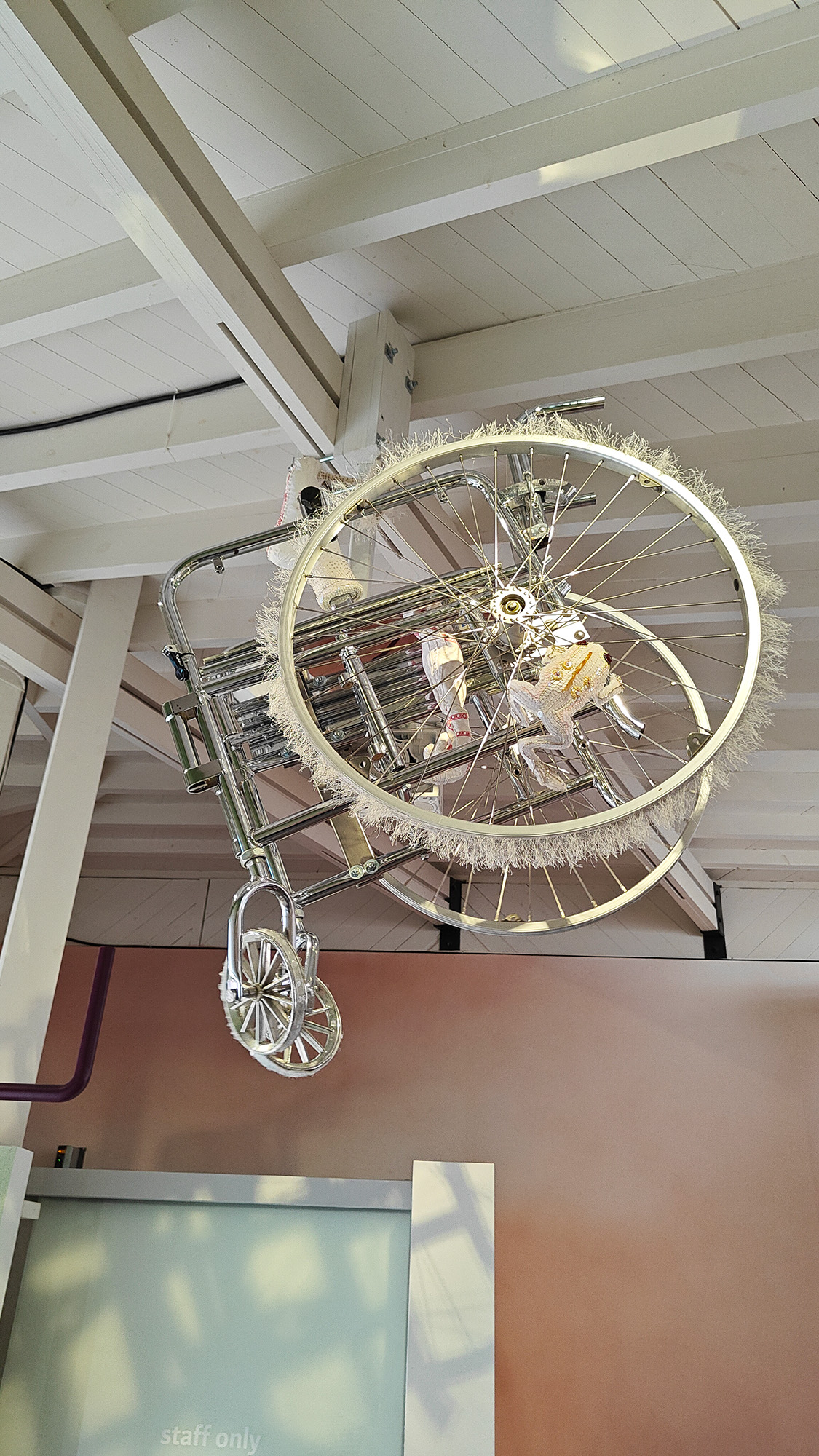
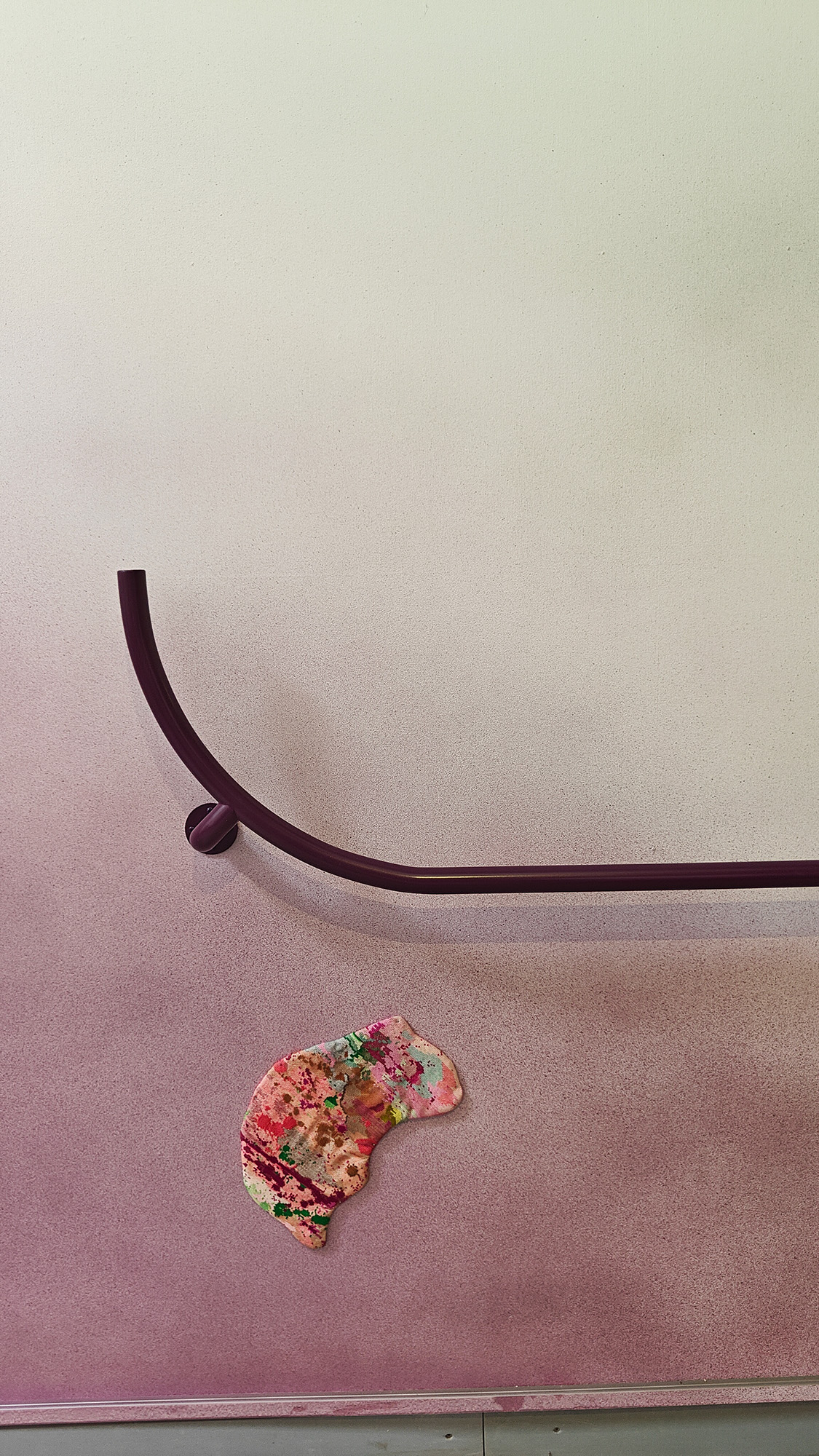


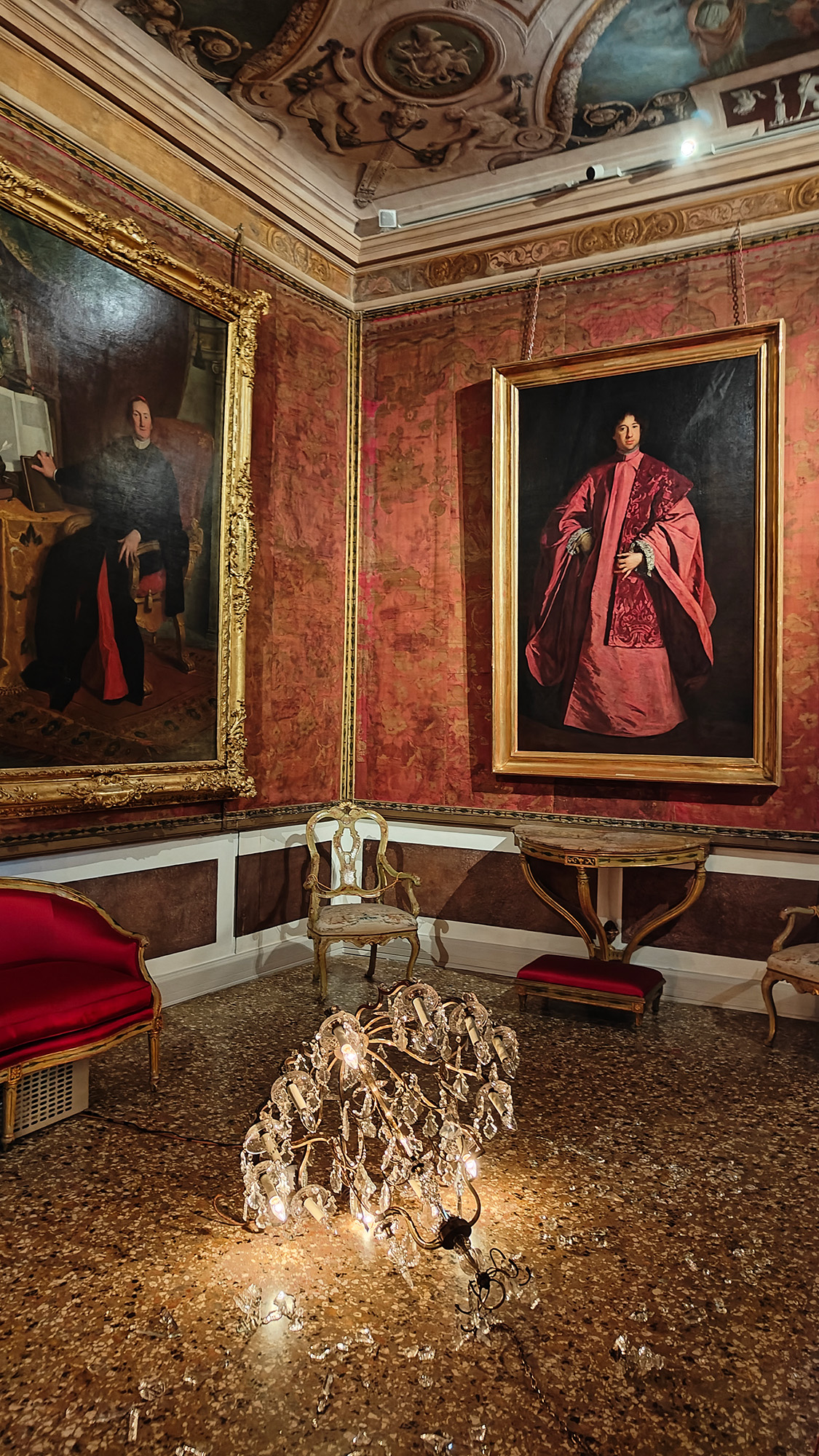
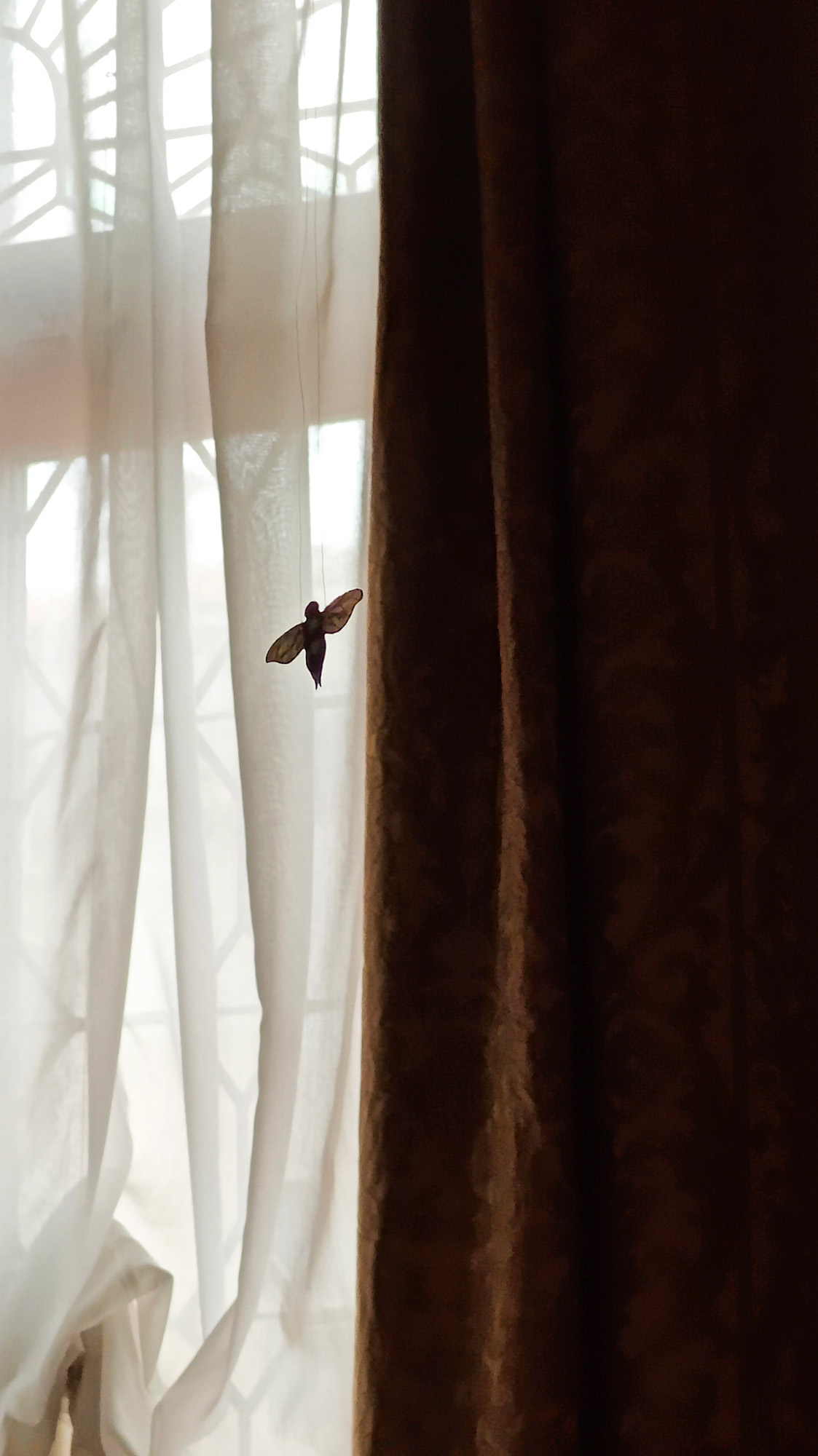
Ilya
& Emilia Kabakov
Between Heaven and Earth
Fondazione Querini Stampalia
While the work of Yoo Youngkuk was presented in the Fondazione Querini Stampalia’s Carlo Scarpa-designed galleries (see 00205) the historic parts of the house were a backdrop to a short-run installation of works by Ilya and Emilia Kabakov, one year after Ilya’s passing. The Kabakov’s are richly entwined with Venice Biennale history, so this is a romantic return of their work to the city, with five of their works scattered amongst the grand palazzo. A light-touch installation that didn’t try to emulate the scale, swagger, or ambition of the Kabakov’s largest works, it offered a subtle push of the historic fabric of the place into surreality, poetry, and memory.
more info:
Between Heaven and Earth
Fondazione Querini Stampalia
While the work of Yoo Youngkuk was presented in the Fondazione Querini Stampalia’s Carlo Scarpa-designed galleries (see 00205) the historic parts of the house were a backdrop to a short-run installation of works by Ilya and Emilia Kabakov, one year after Ilya’s passing. The Kabakov’s are richly entwined with Venice Biennale history, so this is a romantic return of their work to the city, with five of their works scattered amongst the grand palazzo. A light-touch installation that didn’t try to emulate the scale, swagger, or ambition of the Kabakov’s largest works, it offered a subtle push of the historic fabric of the place into surreality, poetry, and memory.
more info:
www.ropac.net/exhibitions/703-ilya-emilia-kabakov-between-heaven-and-earth-a-tribute-to-ilya
Julie
Mehretu
Ensemble
Palazzo Grassi
We reported from Pierre Huyghe’s exhibition at the Punta della Dogana (00207) and a short walk away in the Pinault Collection’s other, equally grand, location Ethiopian artist Julie Mehretu presents a vast presentation with intervention from selected guests. Celebrated for her deep psychogeographic approach to rendering architectural, social, and cultural history into canvases of compressed plans, elevations, lines, and forms, Mehretu brings to Venice works made over the last twenty years. Architecture is abstracted to outline of form and meaning in large canvases hung in a chronological curation across the palace reworked by Tadao Ando in 2007, with works by artists including Tacita Dean, Nairy Baghramian, and David Hammons given space to riff off Mehretu’s flat fields. The exhibition runs through to January before it moves on to K21–Kunstsammlung Nordrhein-Westfalen in Düsseldorf.
Ensemble
Palazzo Grassi
We reported from Pierre Huyghe’s exhibition at the Punta della Dogana (00207) and a short walk away in the Pinault Collection’s other, equally grand, location Ethiopian artist Julie Mehretu presents a vast presentation with intervention from selected guests. Celebrated for her deep psychogeographic approach to rendering architectural, social, and cultural history into canvases of compressed plans, elevations, lines, and forms, Mehretu brings to Venice works made over the last twenty years. Architecture is abstracted to outline of form and meaning in large canvases hung in a chronological curation across the palace reworked by Tadao Ando in 2007, with works by artists including Tacita Dean, Nairy Baghramian, and David Hammons given space to riff off Mehretu’s flat fields. The exhibition runs through to January before it moves on to K21–Kunstsammlung Nordrhein-Westfalen in Düsseldorf.
more info: www.pinaultcollection.com/palazzograssi/en/julie-mehretu-ensemble
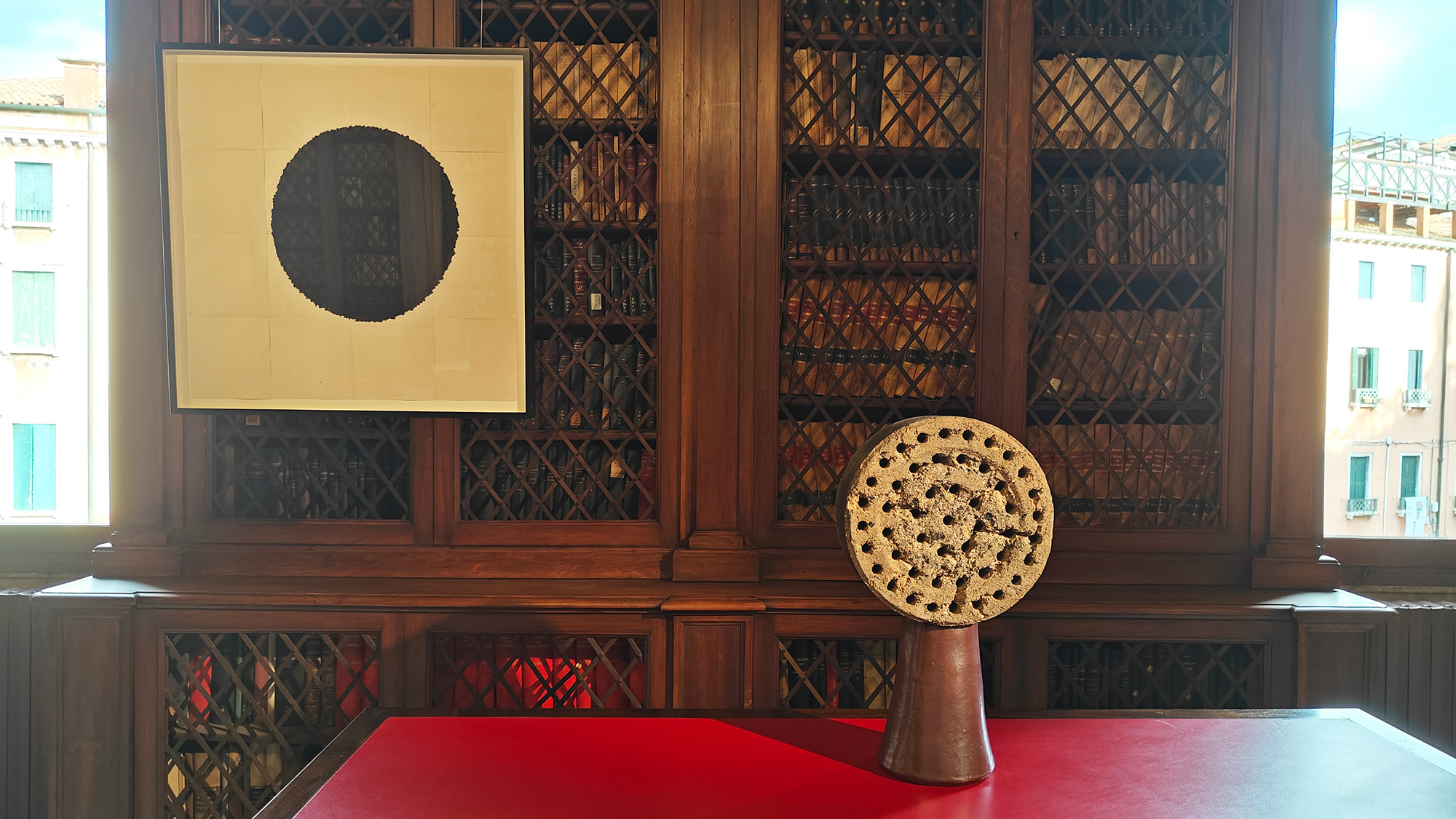
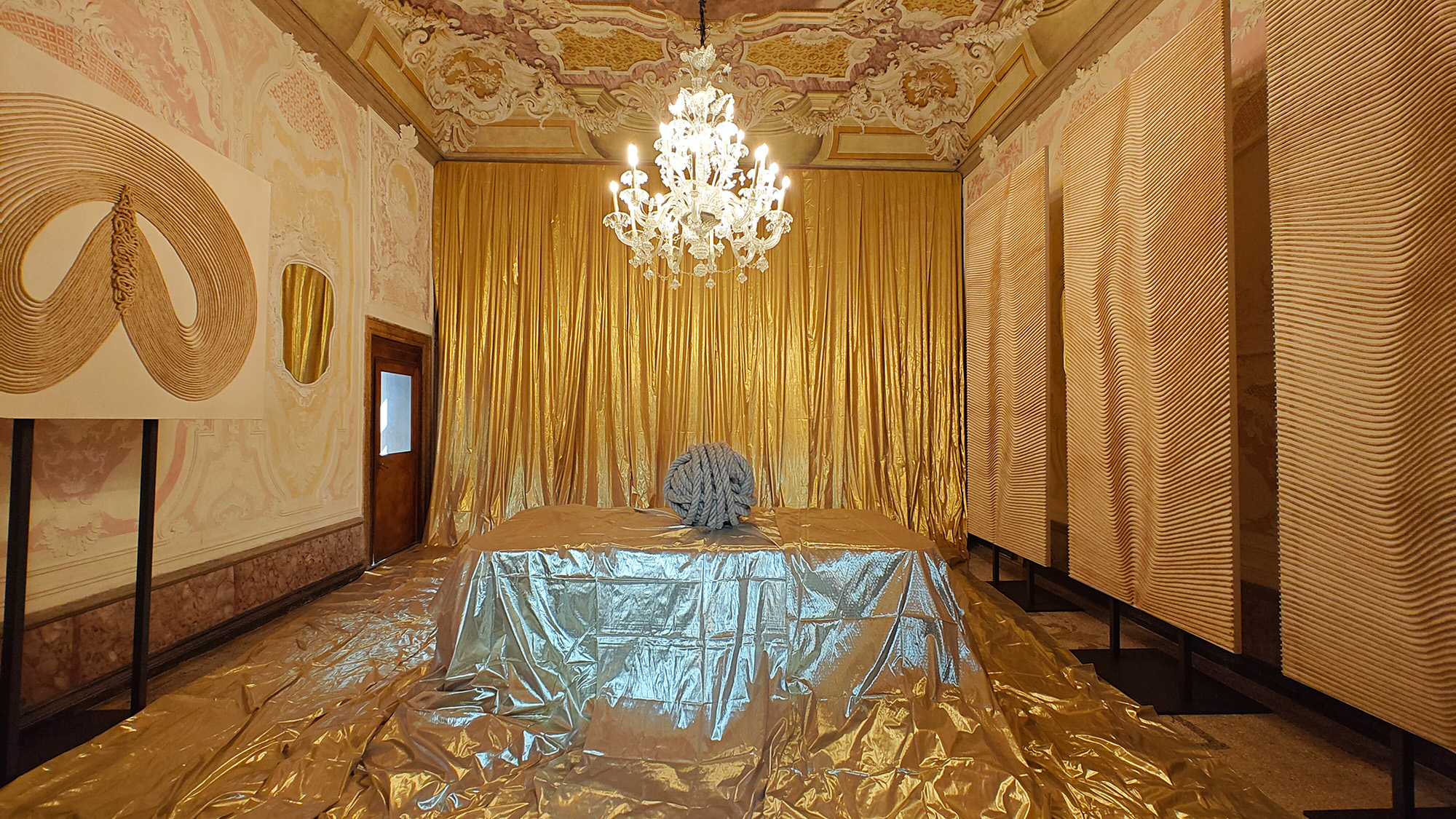
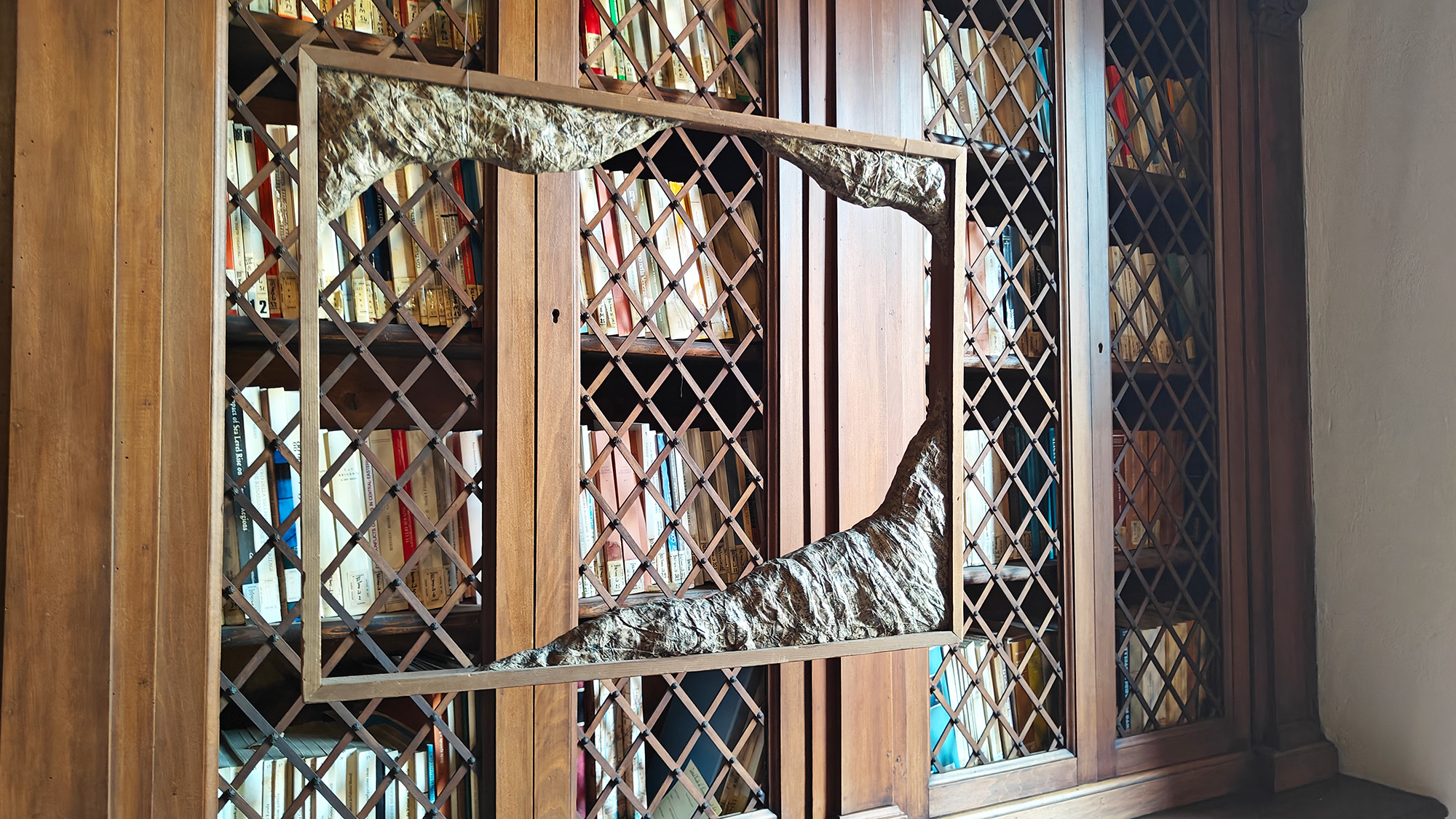
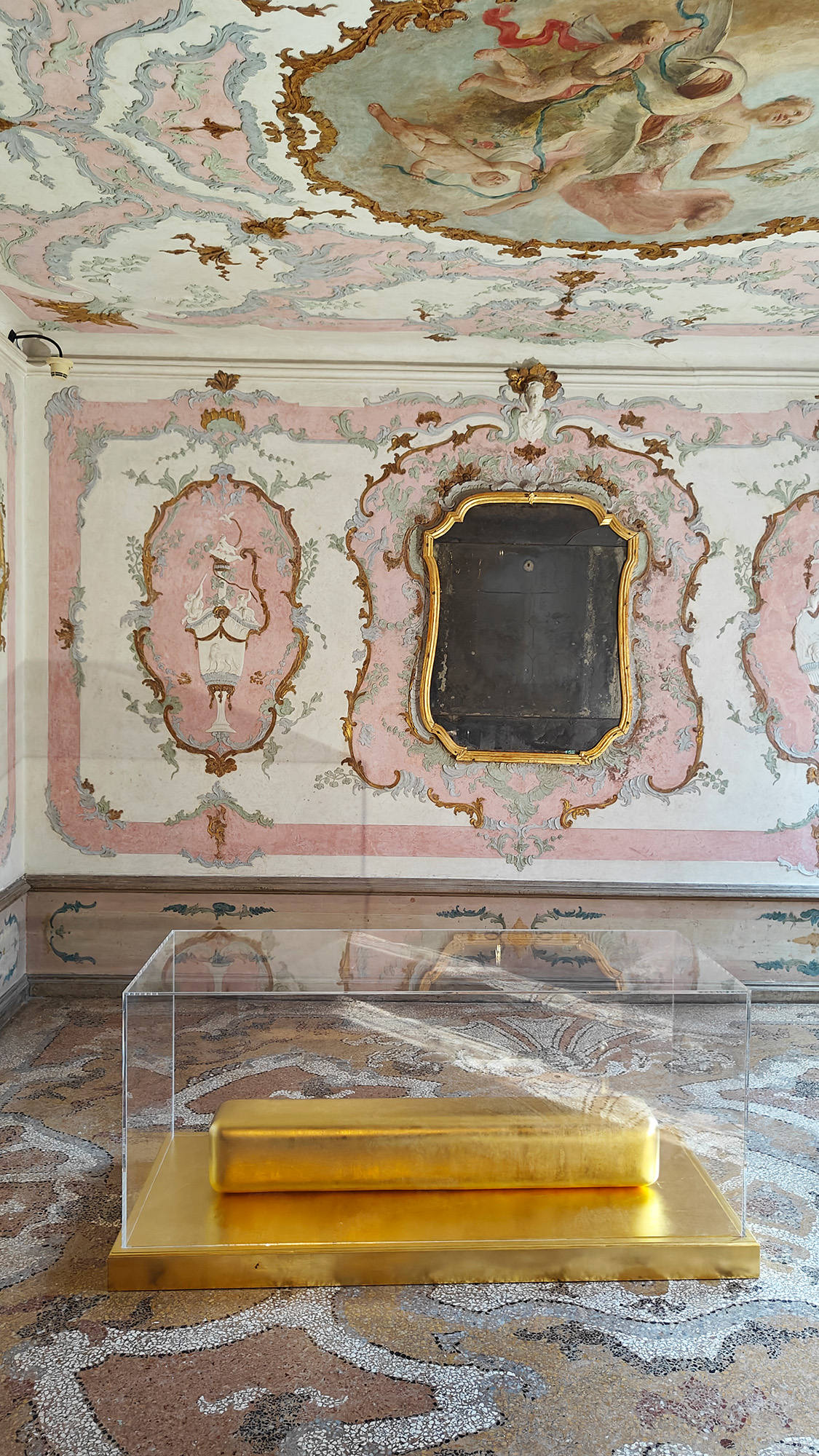
James
Lee Byars & Seung-taek Lee
Invisible questions that fill the air
Palazzo Loredan
In a grand palazzo that’s home to the Istituto Veneto di Scienze, Lettere ed Arti, two artists are presented in conversation with each other and the historic architecture they are set in. An update to a similar pairing held at Michael Werner’s London gallery last year, there are aesthetic and conceptual connections between the two artists, both born in 1932 in Detroit and Kowon (in what is now North Korea). Rich gold works by Byars sing against the wooden fabric of the palazzo amongst pieces that play with volume, while Lee’s work is often dealing with absence and hollows.
Invisible questions that fill the air
Palazzo Loredan
In a grand palazzo that’s home to the Istituto Veneto di Scienze, Lettere ed Arti, two artists are presented in conversation with each other and the historic architecture they are set in. An update to a similar pairing held at Michael Werner’s London gallery last year, there are aesthetic and conceptual connections between the two artists, both born in 1932 in Detroit and Kowon (in what is now North Korea). Rich gold works by Byars sing against the wooden fabric of the palazzo amongst pieces that play with volume, while Lee’s work is often dealing with absence and hollows.
Kapwani
Kiwanga
Trinket
Canadian pavilion
At distance, this wrapping of Canada’s national pavilion seems simple or even underwhelming, but it reveals a depth and complexity up close. Using Conterie, tiny glass seed beads that originate from 16th century Murano and dispersed into global material cultures as currency or items of exchange, Kiwanga created an immense bead-on-string wrap for the inside and outside of the building, transforming it from shell into subject. Raising questions of socioeconomics, value, and trade, the work is unapologetically highly ornamental, shimmering in the light and revealing more of its nuanced pattern, folding its spatial form into a two-dimensional system, with occasional sculptures to bring depth to the presentation.
more info: www.gallery.ca/whats-on/touring-exhibitions-and-loans/around-the-world/canada-pavilion-at-the-venice-biennale/kapwani-kiwanga-trinket
Trinket
Canadian pavilion
At distance, this wrapping of Canada’s national pavilion seems simple or even underwhelming, but it reveals a depth and complexity up close. Using Conterie, tiny glass seed beads that originate from 16th century Murano and dispersed into global material cultures as currency or items of exchange, Kiwanga created an immense bead-on-string wrap for the inside and outside of the building, transforming it from shell into subject. Raising questions of socioeconomics, value, and trade, the work is unapologetically highly ornamental, shimmering in the light and revealing more of its nuanced pattern, folding its spatial form into a two-dimensional system, with occasional sculptures to bring depth to the presentation.
more info: www.gallery.ca/whats-on/touring-exhibitions-and-loans/around-the-world/canada-pavilion-at-the-venice-biennale/kapwani-kiwanga-trinket
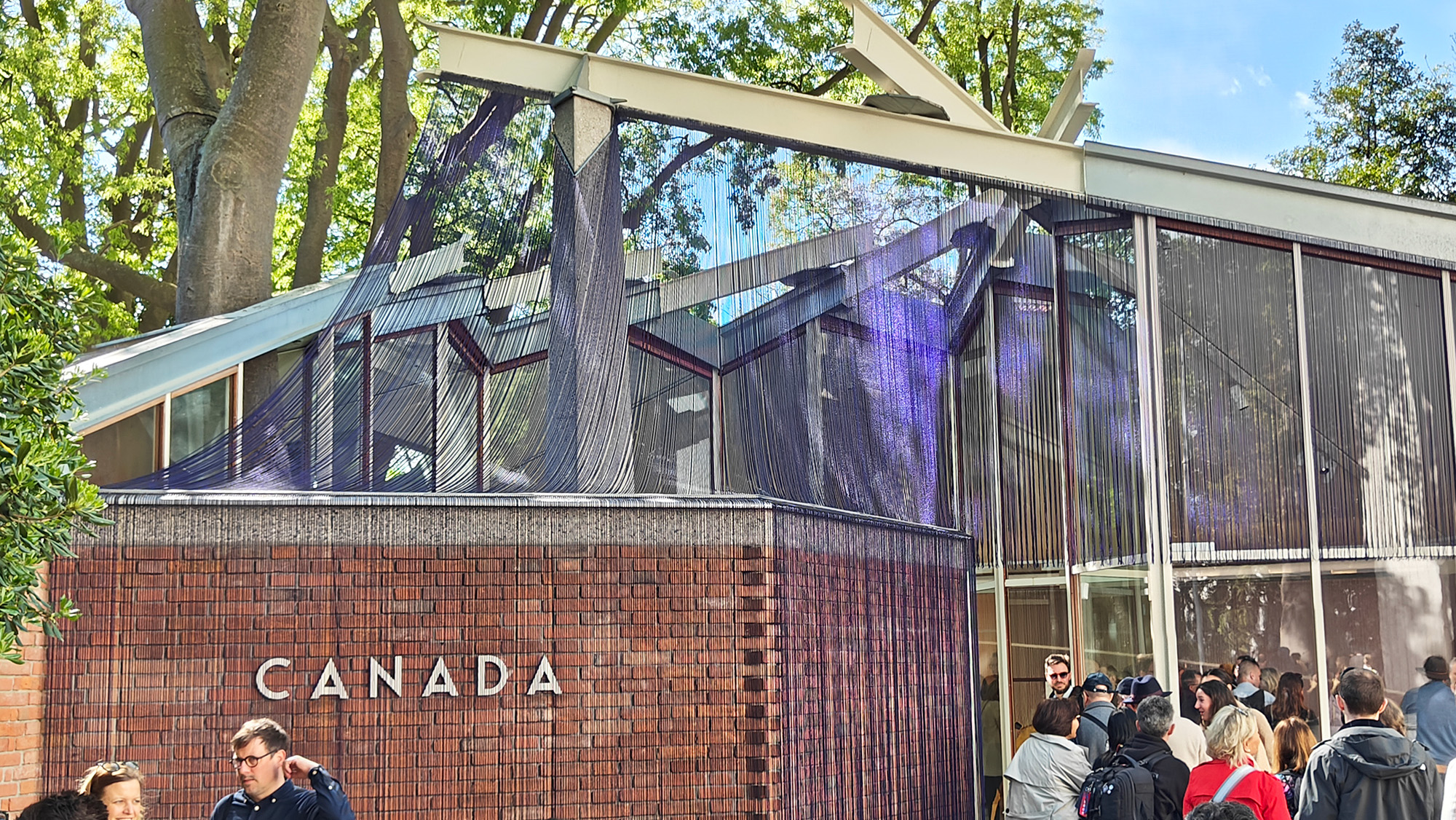
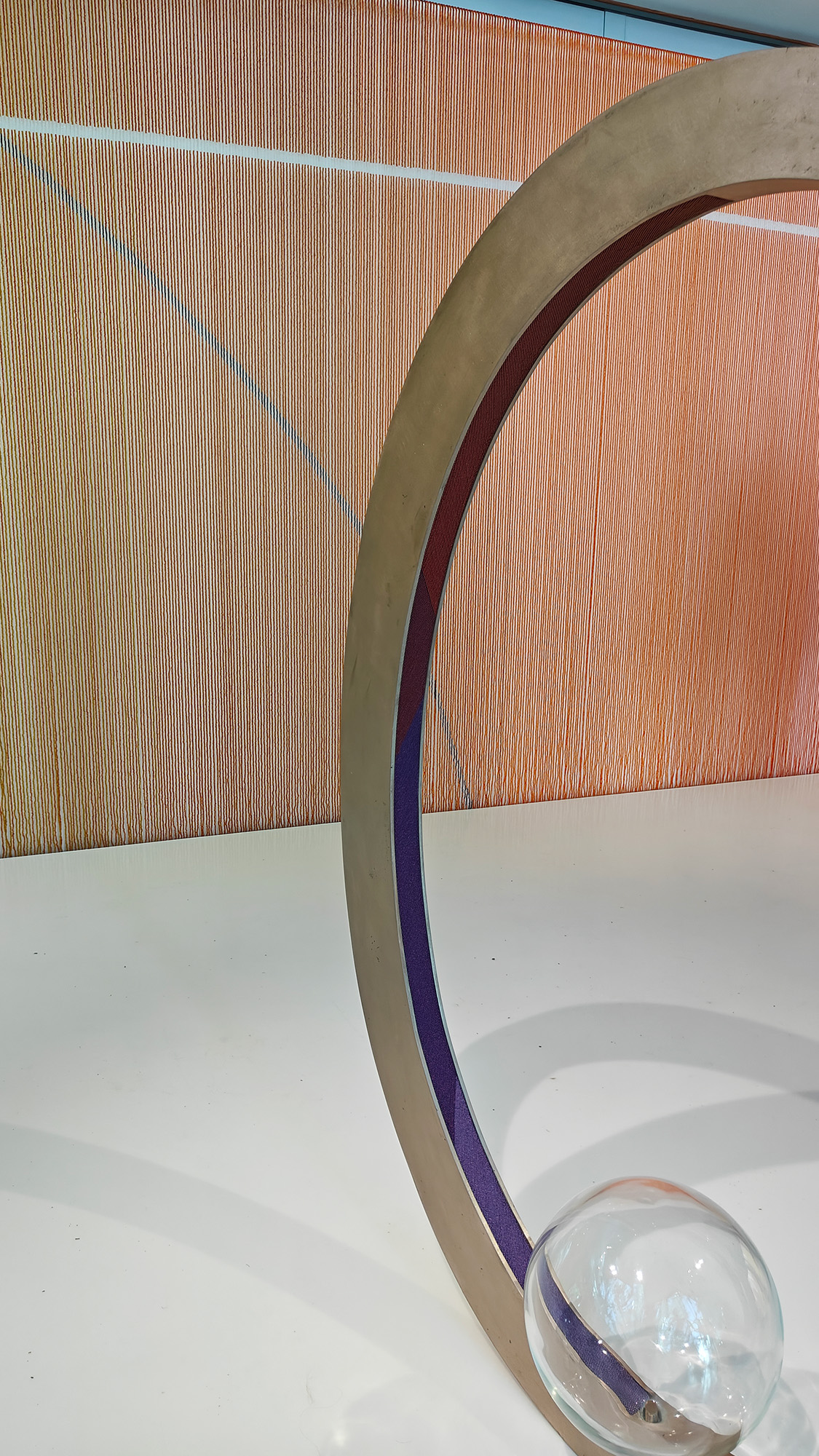
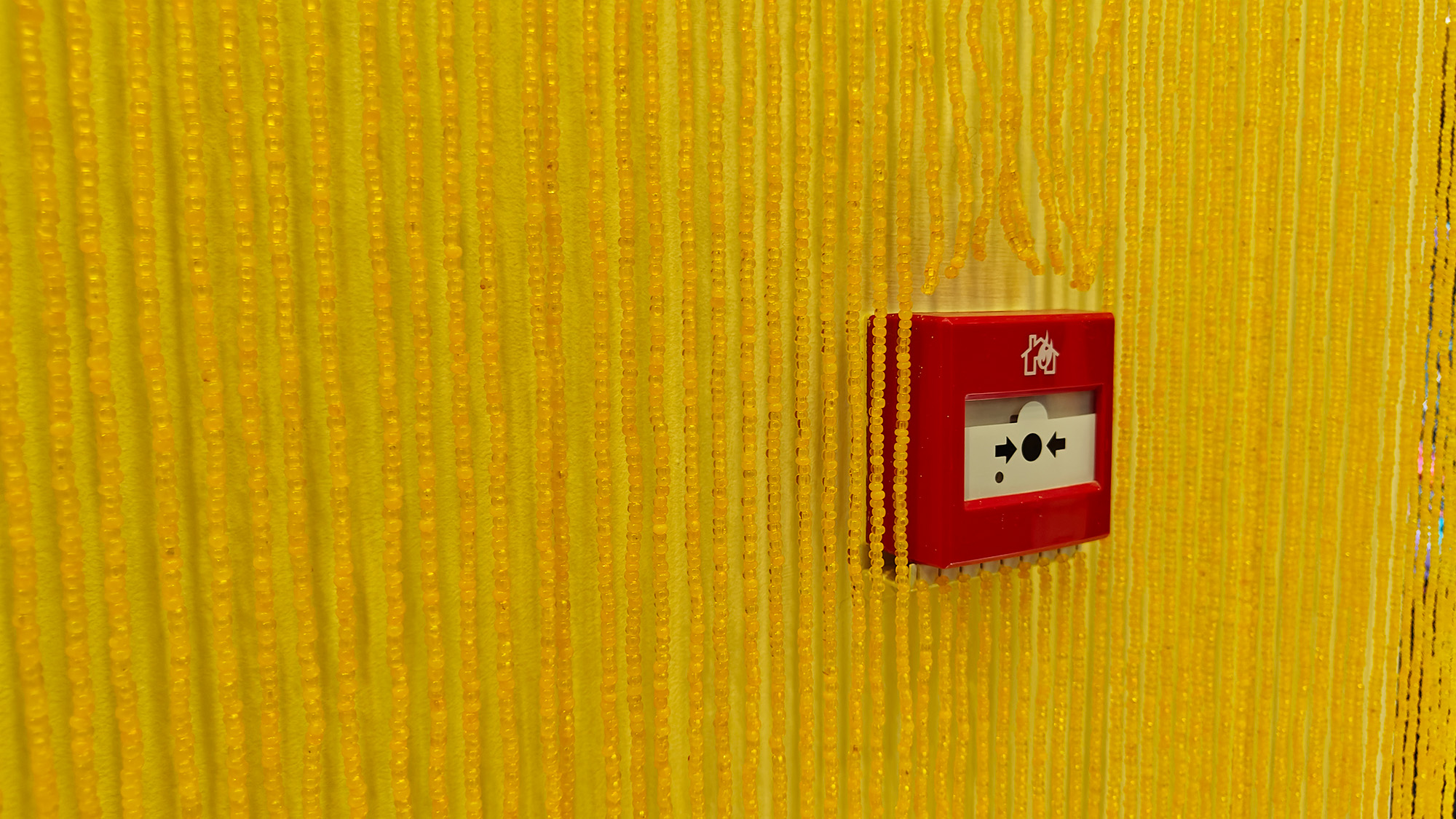
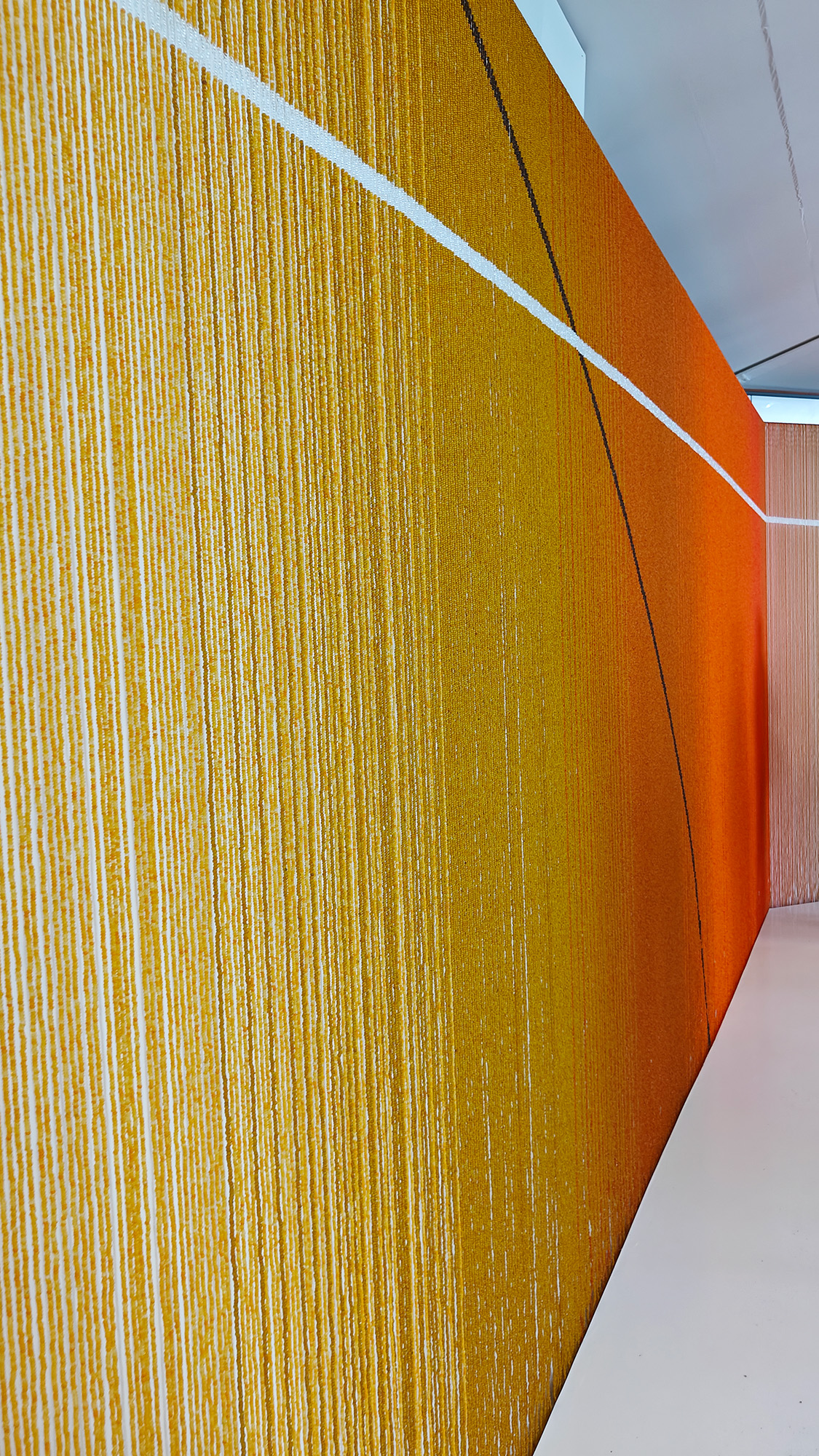

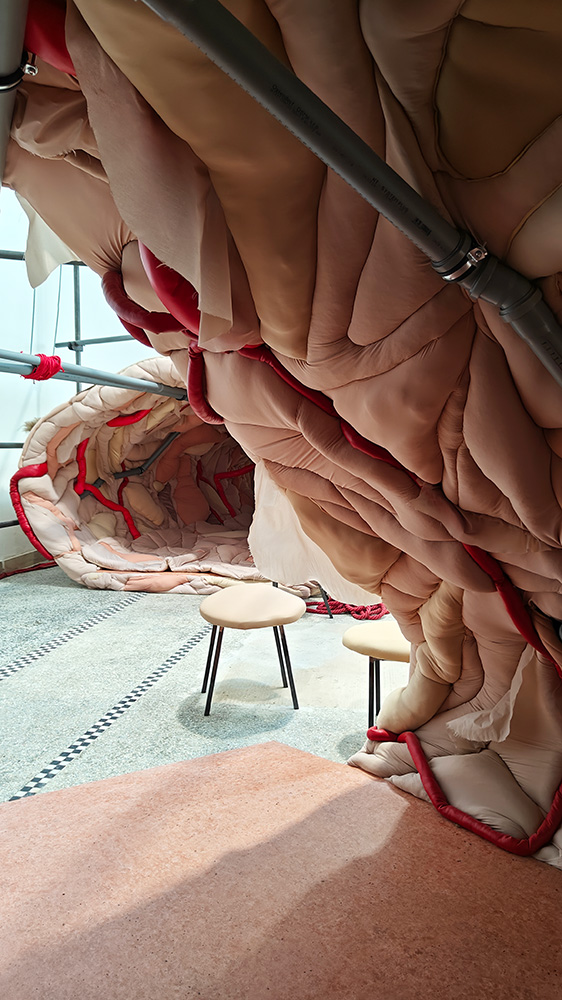
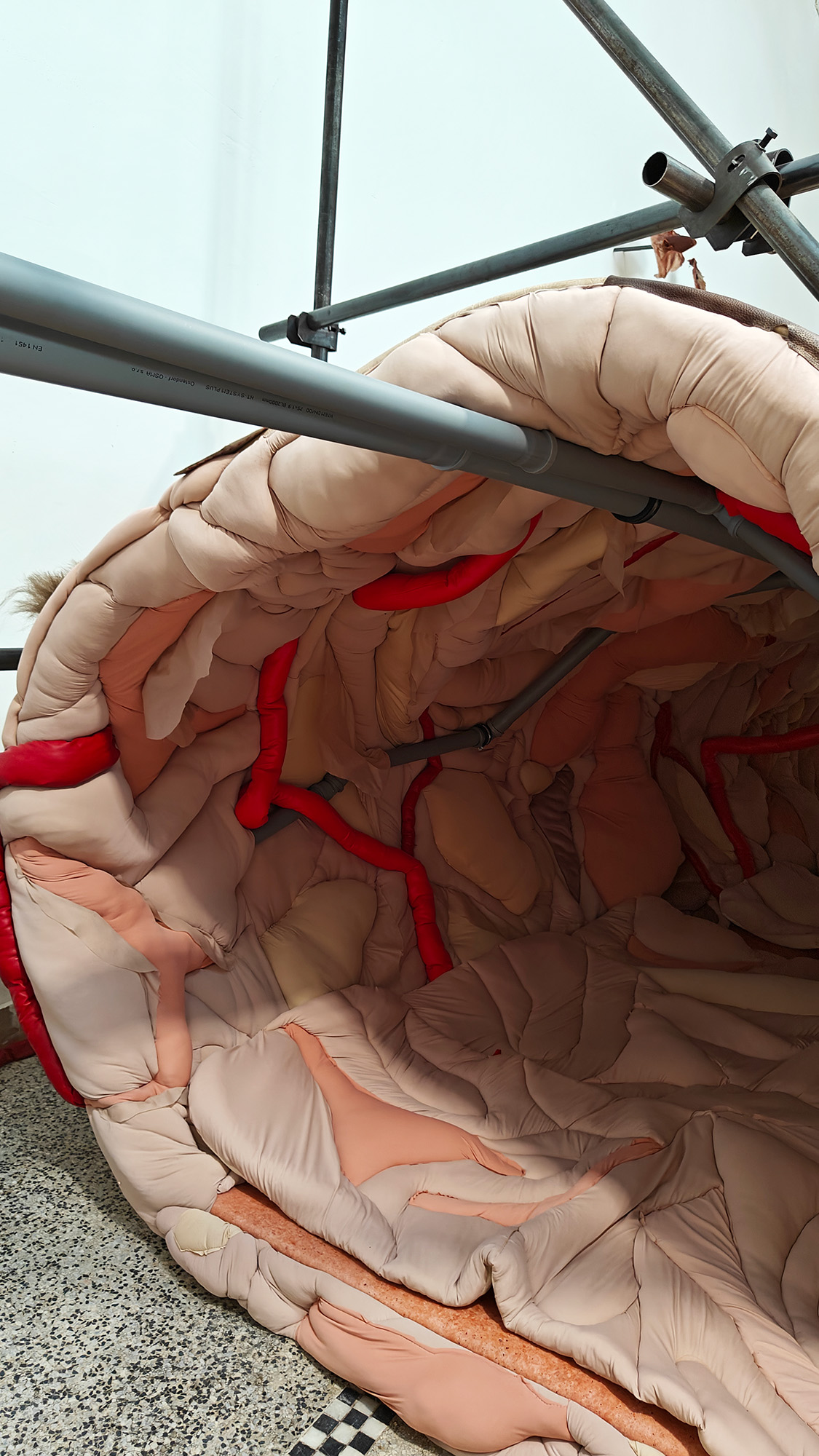
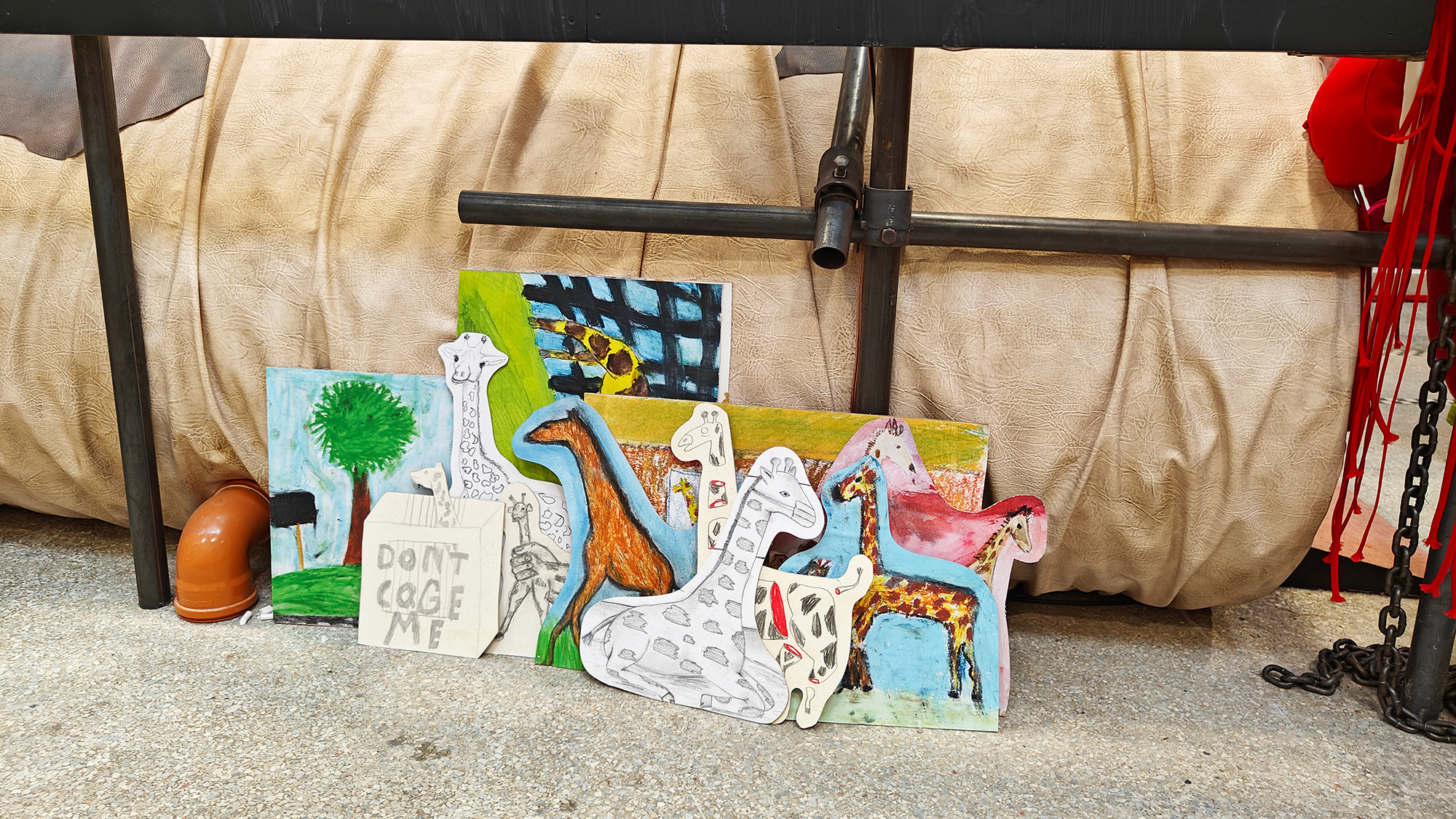
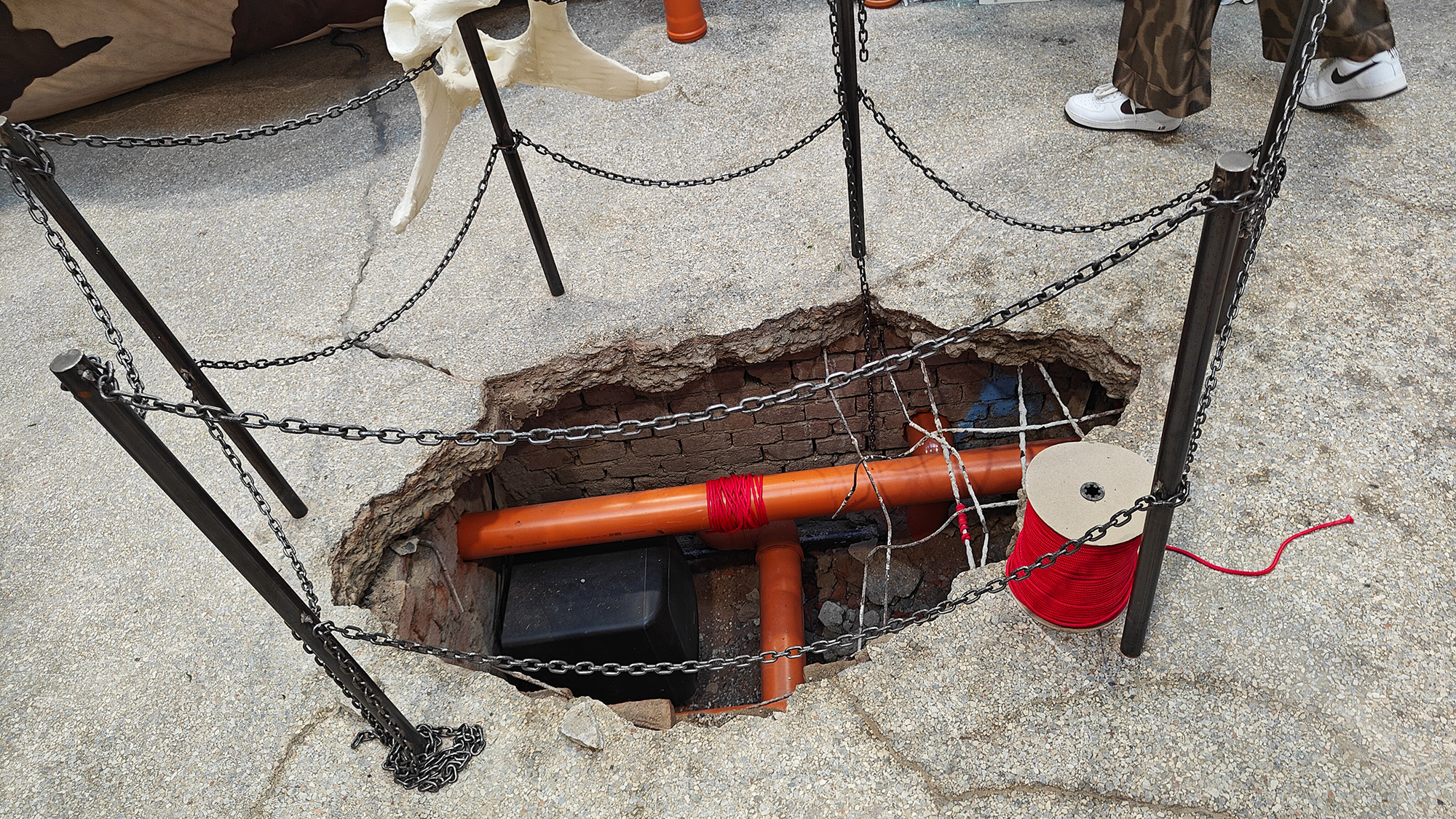
Eva
Koťátková
The heart of a giraffe in captivity is twelve kilos lighter
Czech Republic pavilion
This installation is a true tale with both humour and pathos. It centres the story of Lenka, a Kenyan giraffe captured and taken to Prague in 1954, surviving only two years in captivity. After death, Lenka’s body was displayed in the national museum until 2000. Complications in the body’s preservation process released toxic gasses into the Prague, causing some of the city to be shut down. The tale is explored through an inhabitable, oversized giraffe body with aural memories, children’s drawings, and compositions from Jimali Singh Soin and David Soin Tappeser exploring ideas of decolonisation and our relationship to animals.
The heart of a giraffe in captivity is twelve kilos lighter
Czech Republic pavilion
This installation is a true tale with both humour and pathos. It centres the story of Lenka, a Kenyan giraffe captured and taken to Prague in 1954, surviving only two years in captivity. After death, Lenka’s body was displayed in the national museum until 2000. Complications in the body’s preservation process released toxic gasses into the Prague, causing some of the city to be shut down. The tale is explored through an inhabitable, oversized giraffe body with aural memories, children’s drawings, and compositions from Jimali Singh Soin and David Soin Tappeser exploring ideas of decolonisation and our relationship to animals.
more info: www.ngprague.cz/en/event/3924/Venice%20Biennale%202024
Șerban Savu
What work is
Romanian pavilion
Works made over the last fifteen years by Șerban Savu fill the Romanian pavilion in a salon-style hang, looking down upon a room of plinths supporting four scale architectural models. The paintings, inspired by socialist realism, present choreographies of people at work and play across society. The artist is asking what work is, and what it isn’t, across modern neoliberal statehood as well as the socialist history of the country. The models of an apartment block, ruined church, archaeological site, and paintbrush factory, each incorporating a scale mosaic that breaks away from its religious, historical, or political roots to become a space for fragmented meaning and allegory.
What work is
Romanian pavilion
Works made over the last fifteen years by Șerban Savu fill the Romanian pavilion in a salon-style hang, looking down upon a room of plinths supporting four scale architectural models. The paintings, inspired by socialist realism, present choreographies of people at work and play across society. The artist is asking what work is, and what it isn’t, across modern neoliberal statehood as well as the socialist history of the country. The models of an apartment block, ruined church, archaeological site, and paintbrush factory, each incorporating a scale mosaic that breaks away from its religious, historical, or political roots to become a space for fragmented meaning and allegory.
more info: www.idea.ro/fundatia

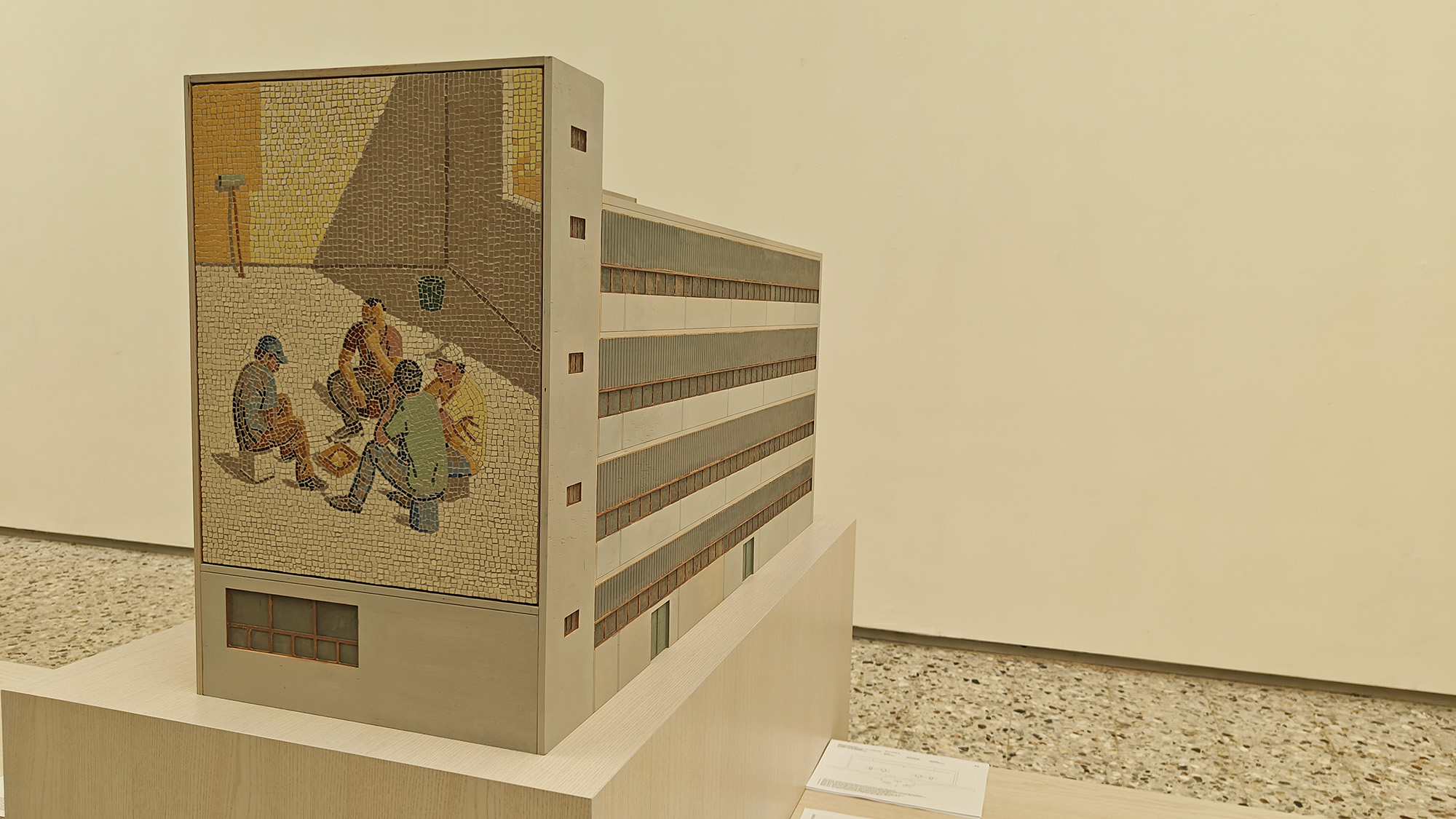




Production still, Eimear Walshe ROMANTIC IRELAND (2023) Photo @ Faolán Carey. Courtesy Eimear Walshe and Ireland at Venice.
Gweedore, Donegal. An evicted family who have rebuilt a house out of the very land from which they were evicted.
Courtesy Eimear Walshe and Ireland at Venice.
Eimear-Walshe, ROMANTIC-IRELAND, installation view, Irish Pavilion, Venice Biennale 2024. Photo: Simon Mills
Eimear
Walshe
Romantic Ireland
Irish pavilion
Late 19th century land contestation and colonisation is explored with installation, film, and operatic soundtrack in Ireland’s pavilion. It’s all set in an abstracted ruin, both under construction and demolition simultaneously, referencing demolition evictions of the 1800s. The semi-demolished houses were still lived in through repair and rebuild using local mud, employing collective earth-building methods with an 11,000 year history. Over the top, a five-voice opera composed by Amanda Feery, with a libretto by Walshe, documents an elderly man speaking to his younger evictors in 1943 as the Taoiseach delivered his St Patrick’s Day Speech, The Ireland That We Dreamed Of – a reference to the modern day nation’s housing crises.
Romantic Ireland
Irish pavilion
Late 19th century land contestation and colonisation is explored with installation, film, and operatic soundtrack in Ireland’s pavilion. It’s all set in an abstracted ruin, both under construction and demolition simultaneously, referencing demolition evictions of the 1800s. The semi-demolished houses were still lived in through repair and rebuild using local mud, employing collective earth-building methods with an 11,000 year history. Over the top, a five-voice opera composed by Amanda Feery, with a libretto by Walshe, documents an elderly man speaking to his younger evictors in 1943 as the Taoiseach delivered his St Patrick’s Day Speech, The Ireland That We Dreamed Of – a reference to the modern day nation’s housing crises.
more info: www.irelandatvenice2024.ie
Wong
Weng Cheong
Above Zobeide
Eshibition from Macau, China
Connections between Macau and Italo Calvino’s Invisible Cities is made in this sci-fi tech and sculptural project. Zobeide was one of Calvino’s cities, a place of desire created through colonisation and globalisation, with parallels made to Macau, place of escape, gambling, and trade. Wong has recreated tableaux from an imaginary overlap, both wild and domestic, with mutant herbivores stalking the landscape. A second room of monitors feeds live footage from the sculptures, catching visitors walking around, siting a subjugated humanity somewhere in the imaginary mix.
Above Zobeide
Eshibition from Macau, China
Connections between Macau and Italo Calvino’s Invisible Cities is made in this sci-fi tech and sculptural project. Zobeide was one of Calvino’s cities, a place of desire created through colonisation and globalisation, with parallels made to Macau, place of escape, gambling, and trade. Wong has recreated tableaux from an imaginary overlap, both wild and domestic, with mutant herbivores stalking the landscape. A second room of monitors feeds live footage from the sculptures, catching visitors walking around, siting a subjugated humanity somewhere in the imaginary mix.
more info: www.mam.gov.mo/en/exhibition/2024_60th_Biennale_Art_AboveZobeide
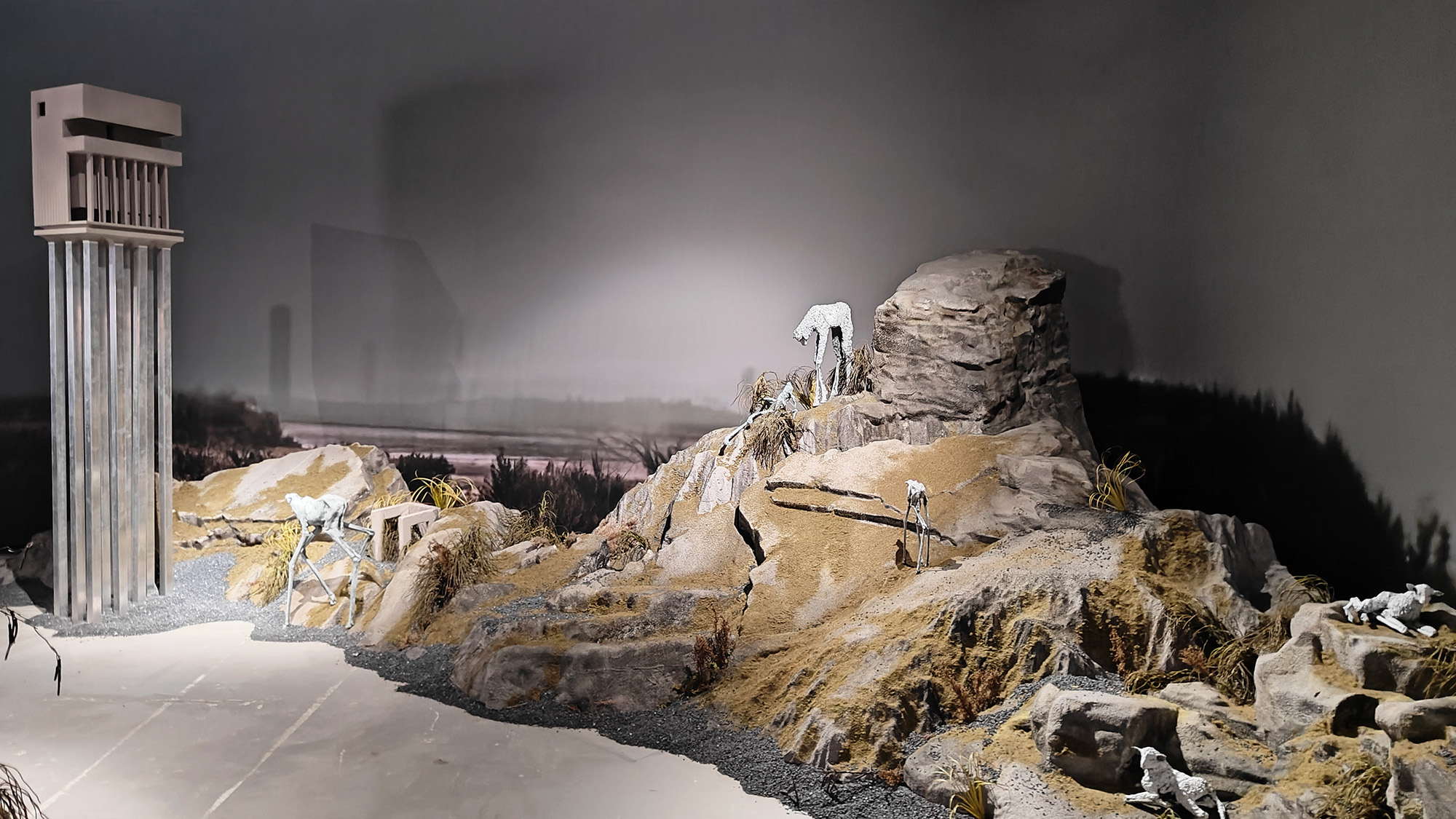
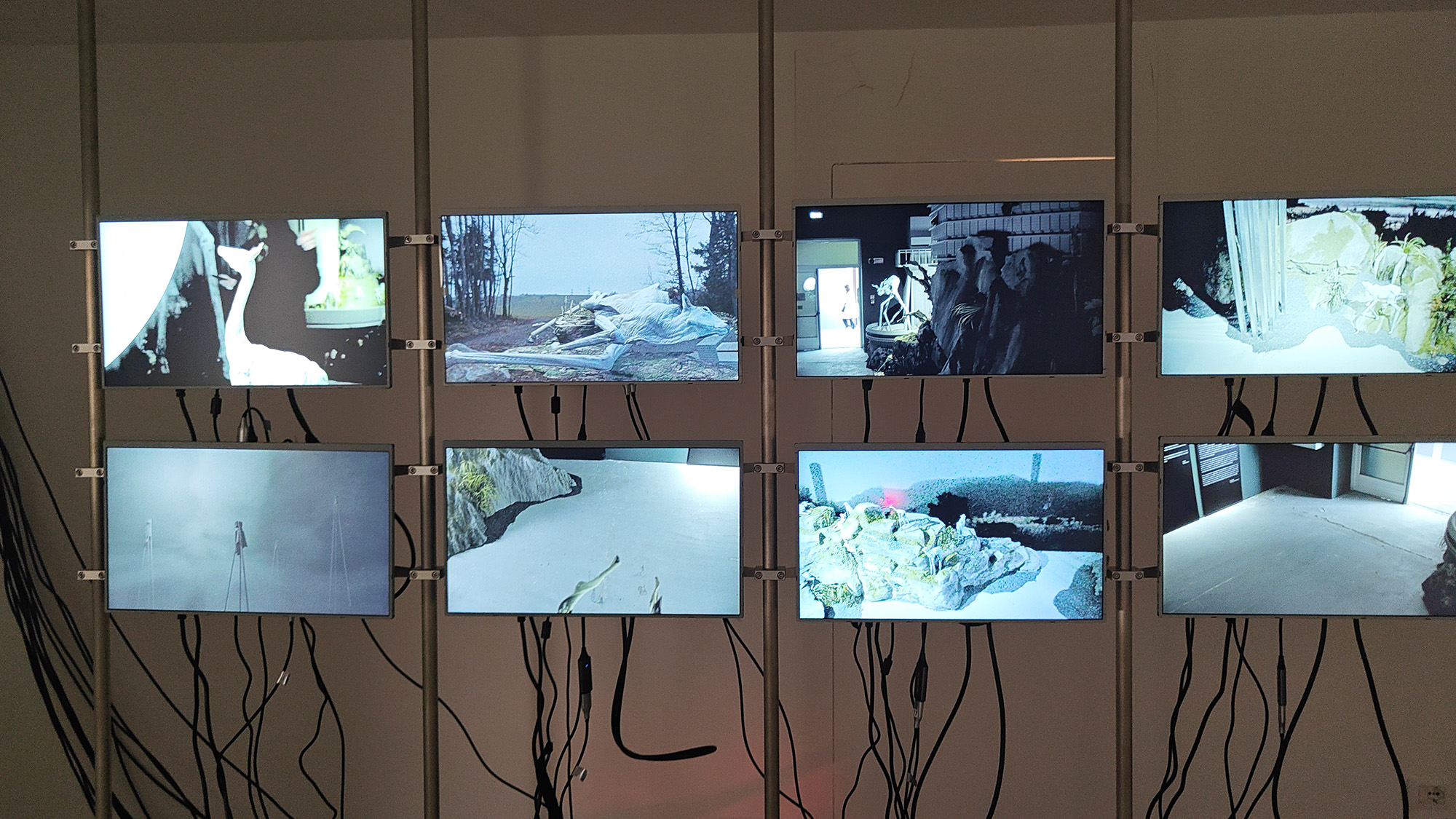
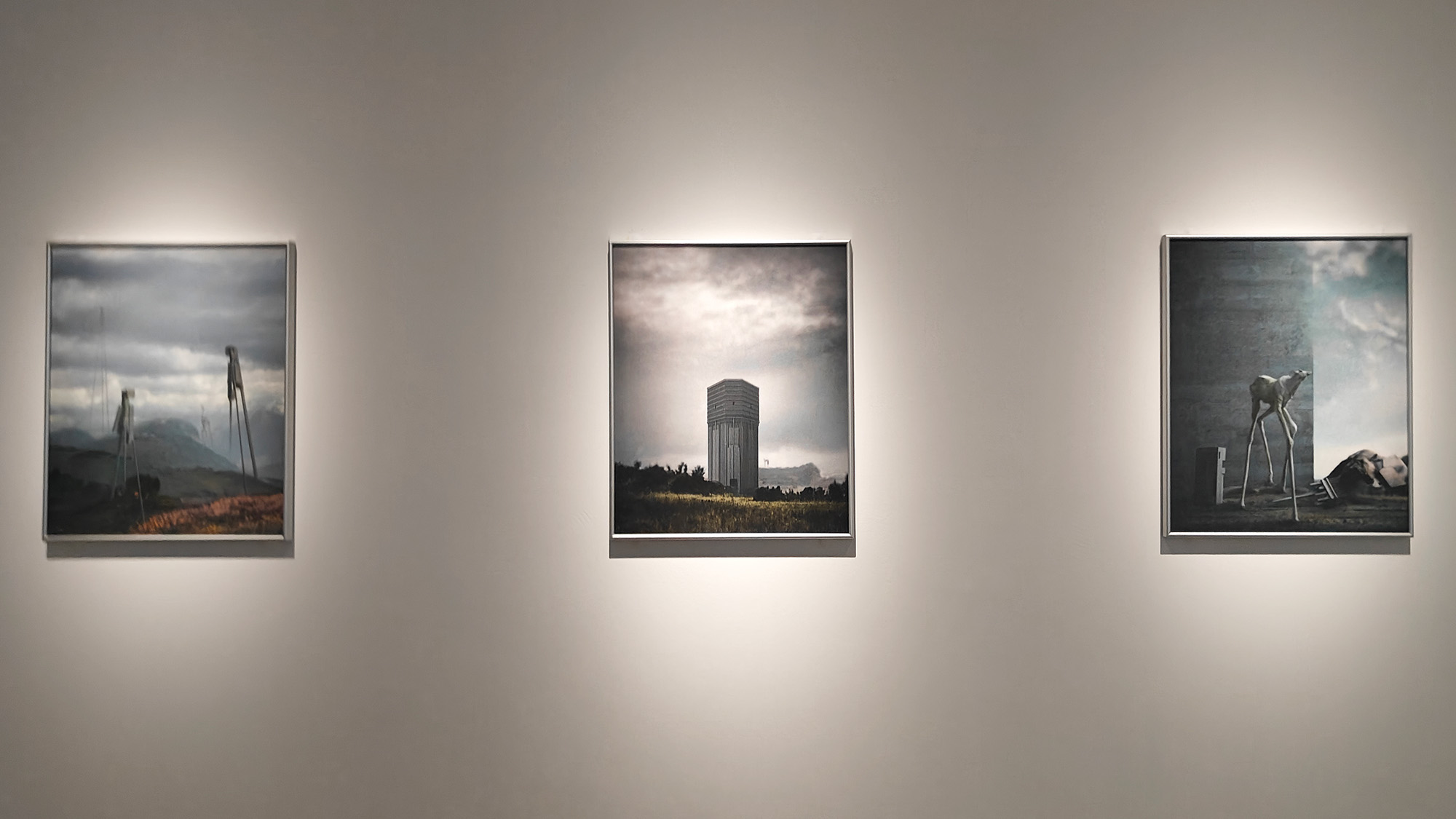
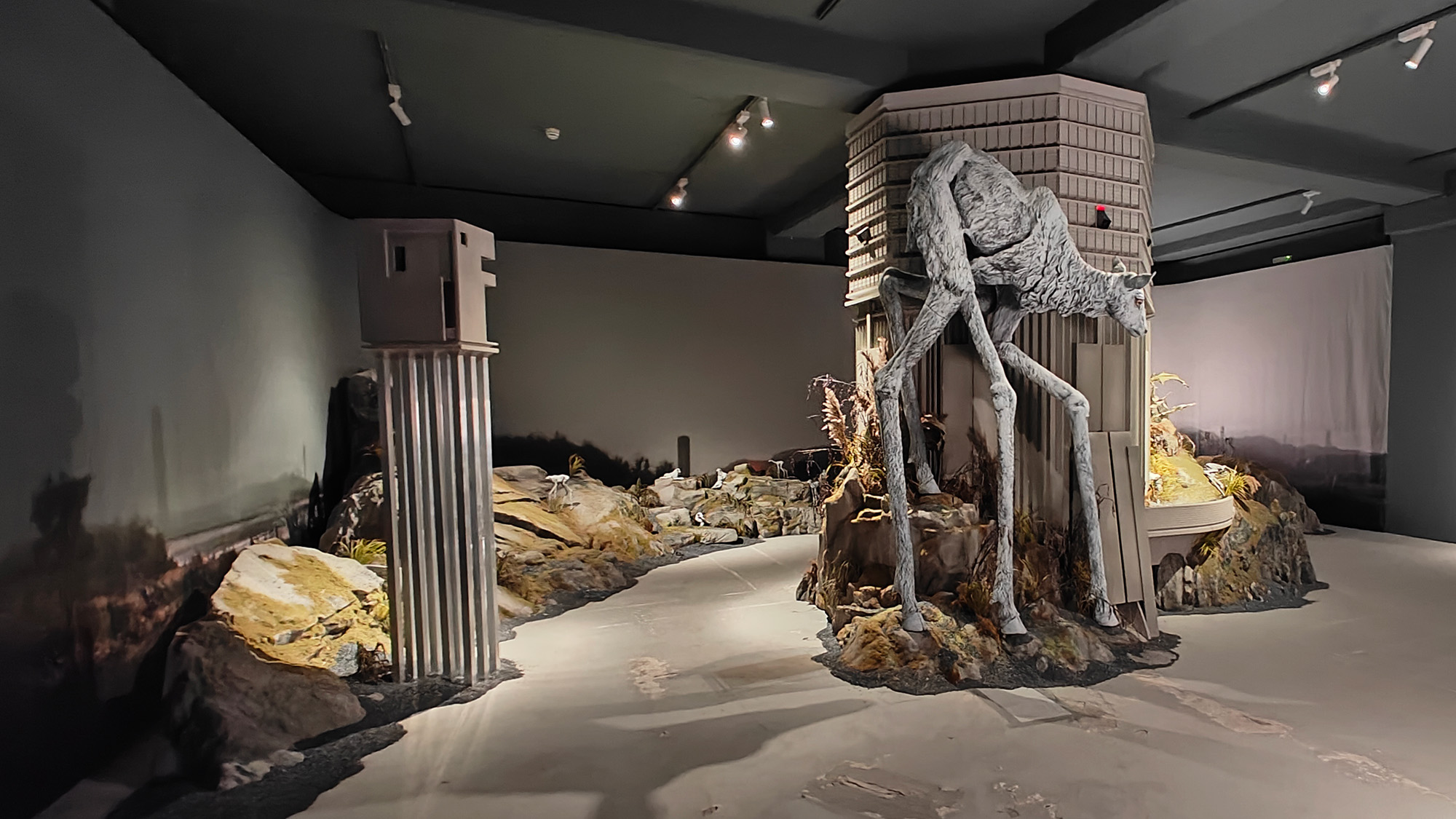

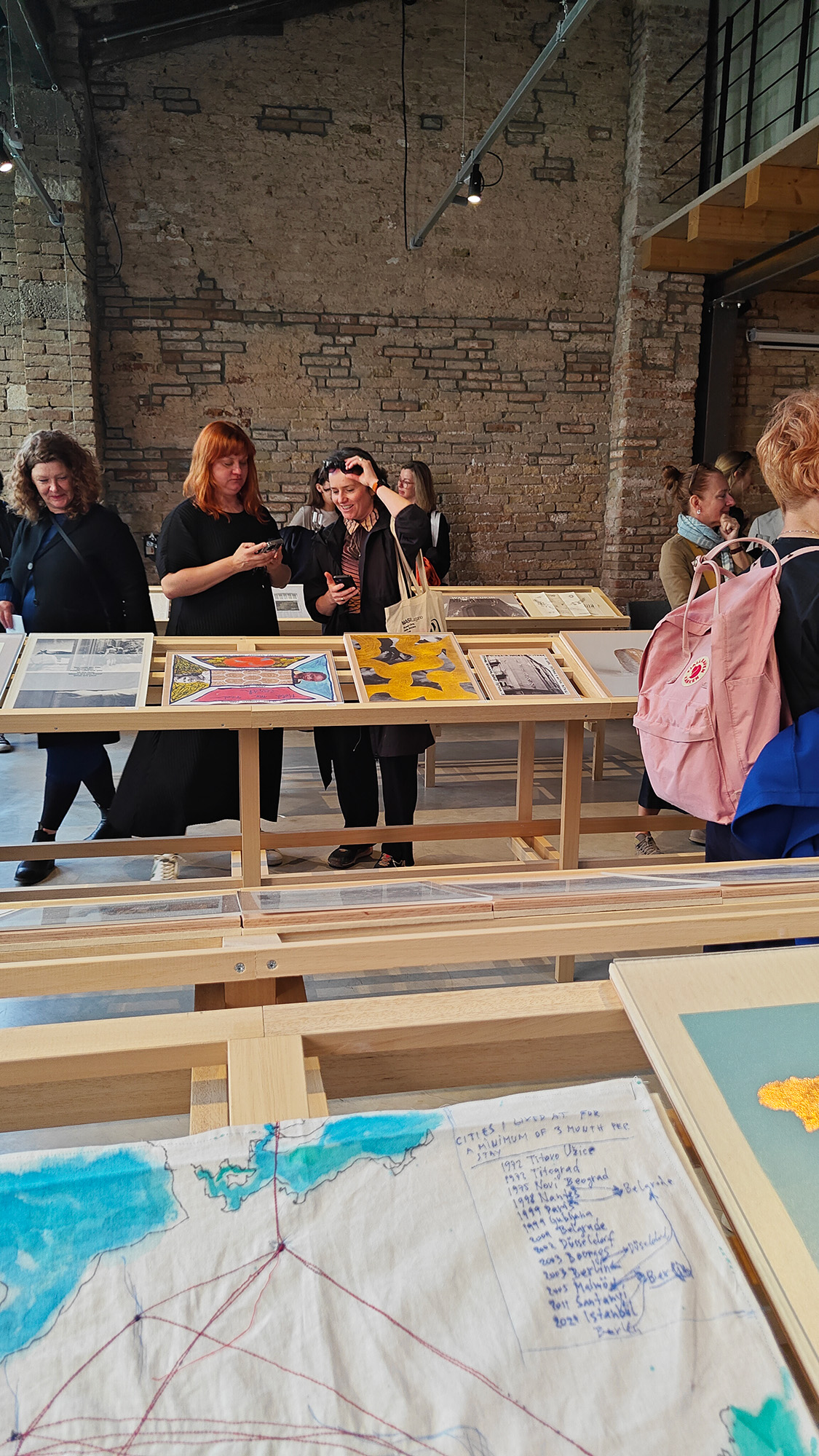

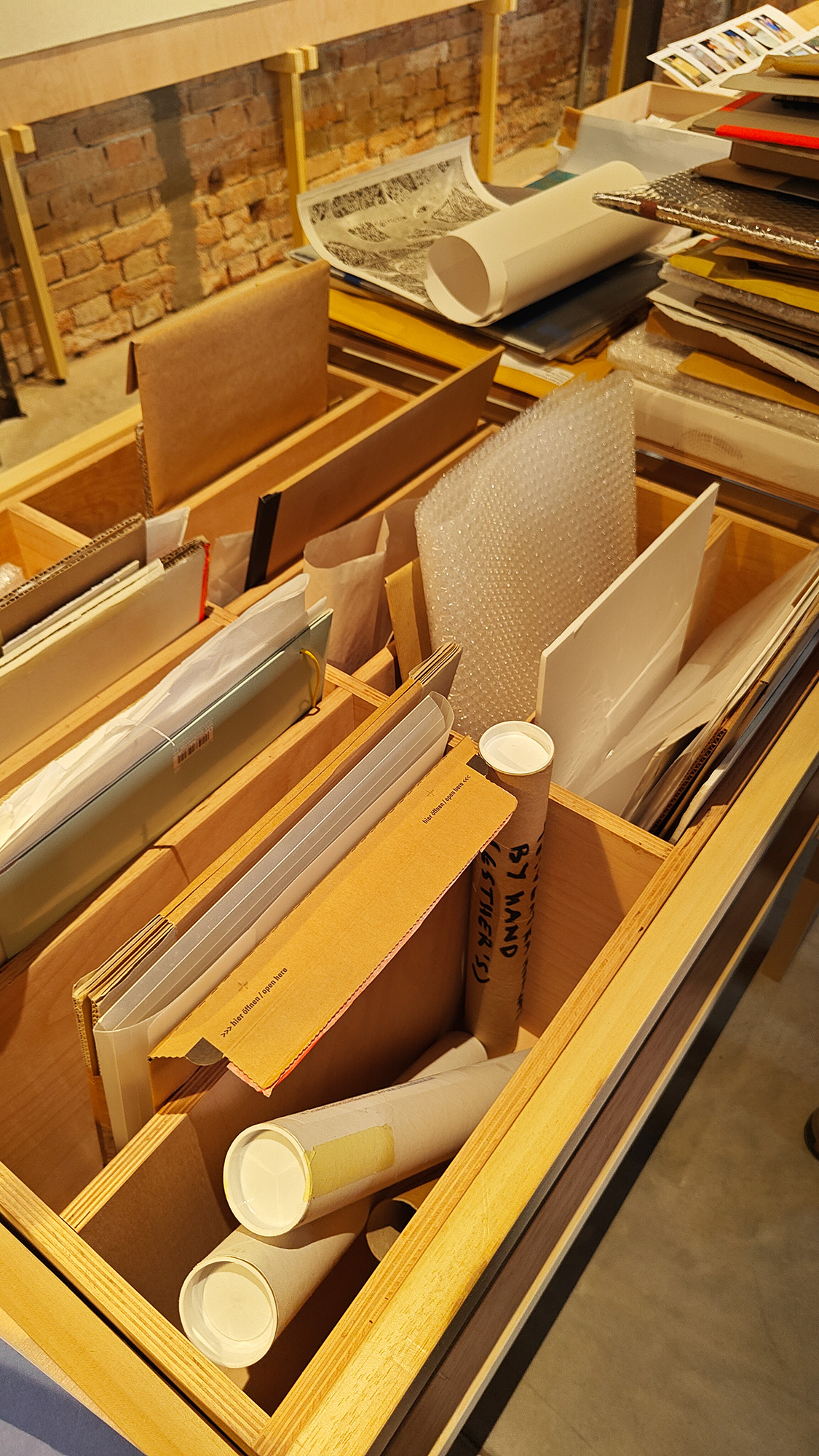
Vlatka
Horvat
By the Means at Hand
Croatian pavilion
Back in 2022, when recessed.space was only a couple of months old, we interviewed London-based artist Vlatka Horvat at PEER gallery (00013). This summer, the artist represented Croatia at the world’s leading Biennial with an empathetic, collaborative, and playfully interconnected project. Horvat asked a large number of artist friends from across the world, all of whom live in a nation other to where they were born, to create a small artwork musing on their experience living in diaspora. The works were then all delivered to Horvat not by post, but through informal networks of friends, associates, or online acquaintances so each artwork was passed along a hand-to-hand connection en route to Venice.
By the Means at Hand
Croatian pavilion
Back in 2022, when recessed.space was only a couple of months old, we interviewed London-based artist Vlatka Horvat at PEER gallery (00013). This summer, the artist represented Croatia at the world’s leading Biennial with an empathetic, collaborative, and playfully interconnected project. Horvat asked a large number of artist friends from across the world, all of whom live in a nation other to where they were born, to create a small artwork musing on their experience living in diaspora. The works were then all delivered to Horvat not by post, but through informal networks of friends, associates, or online acquaintances so each artwork was passed along a hand-to-hand connection en route to Venice.




